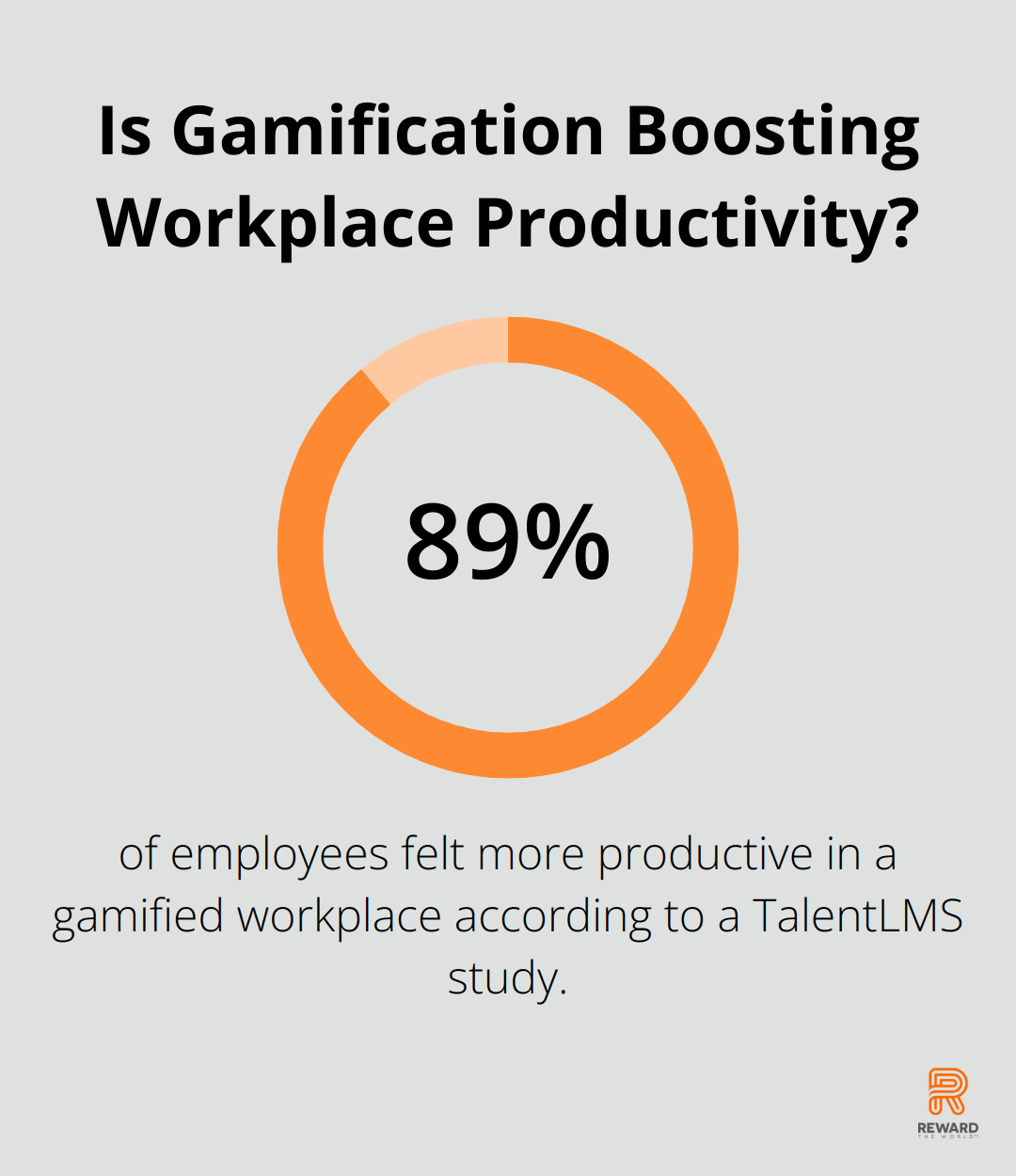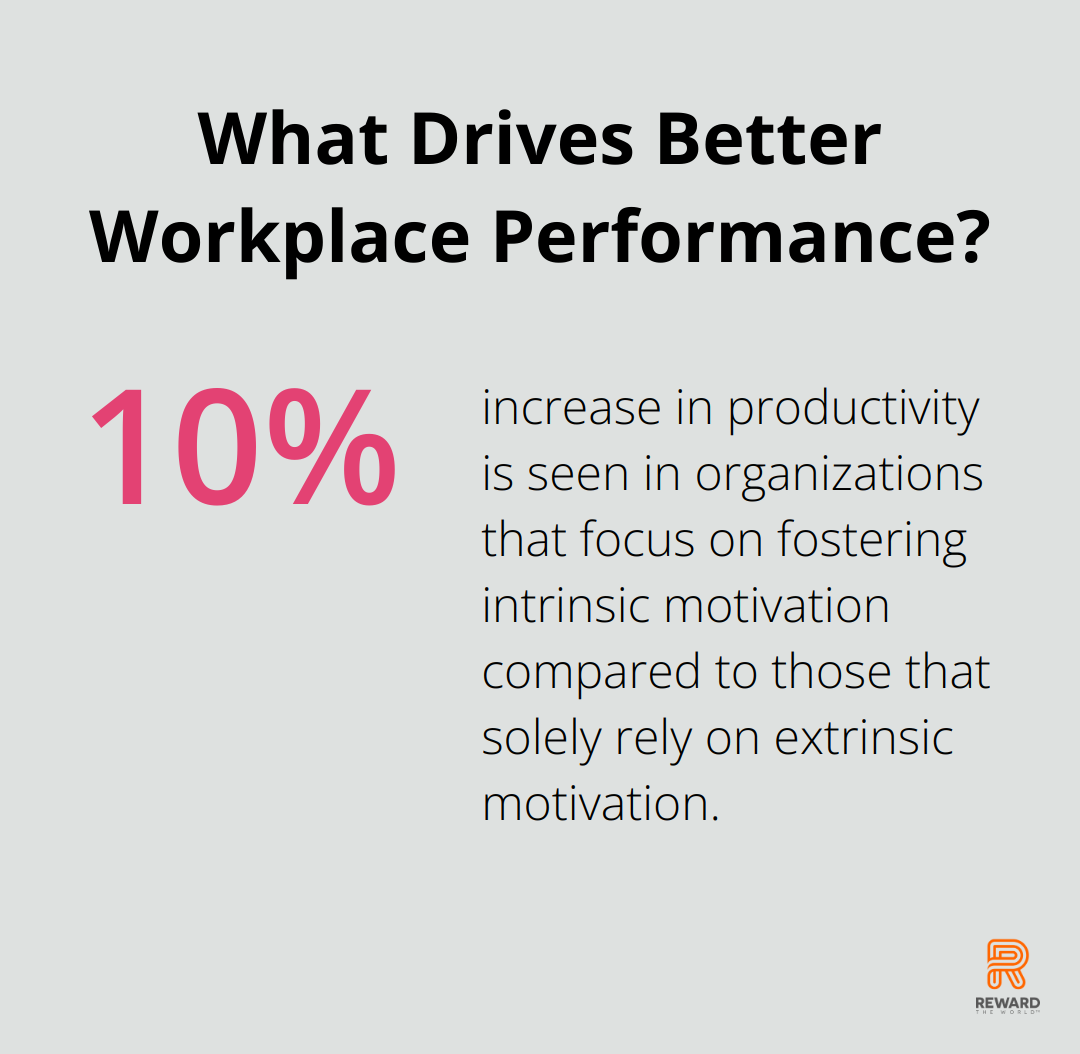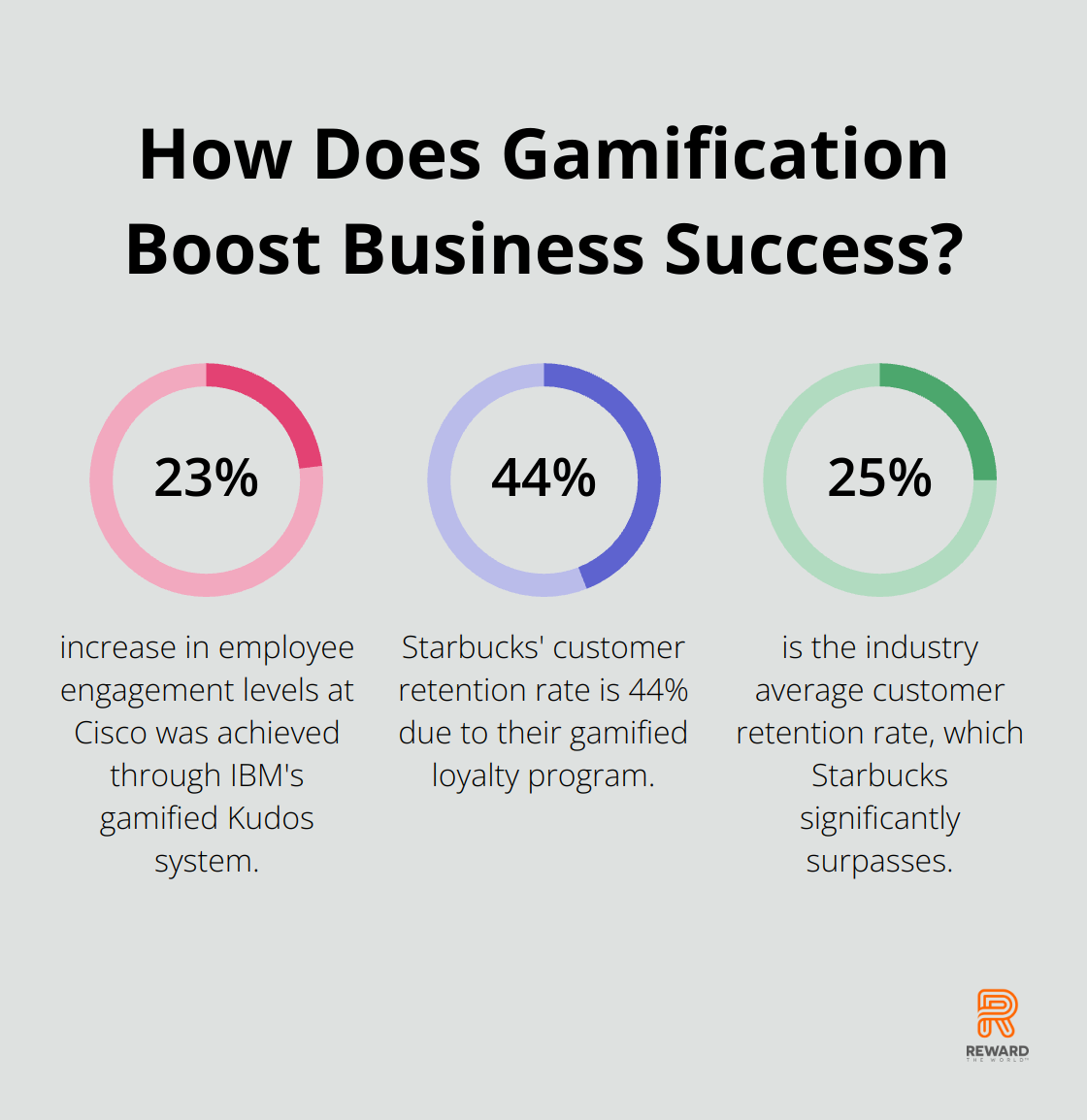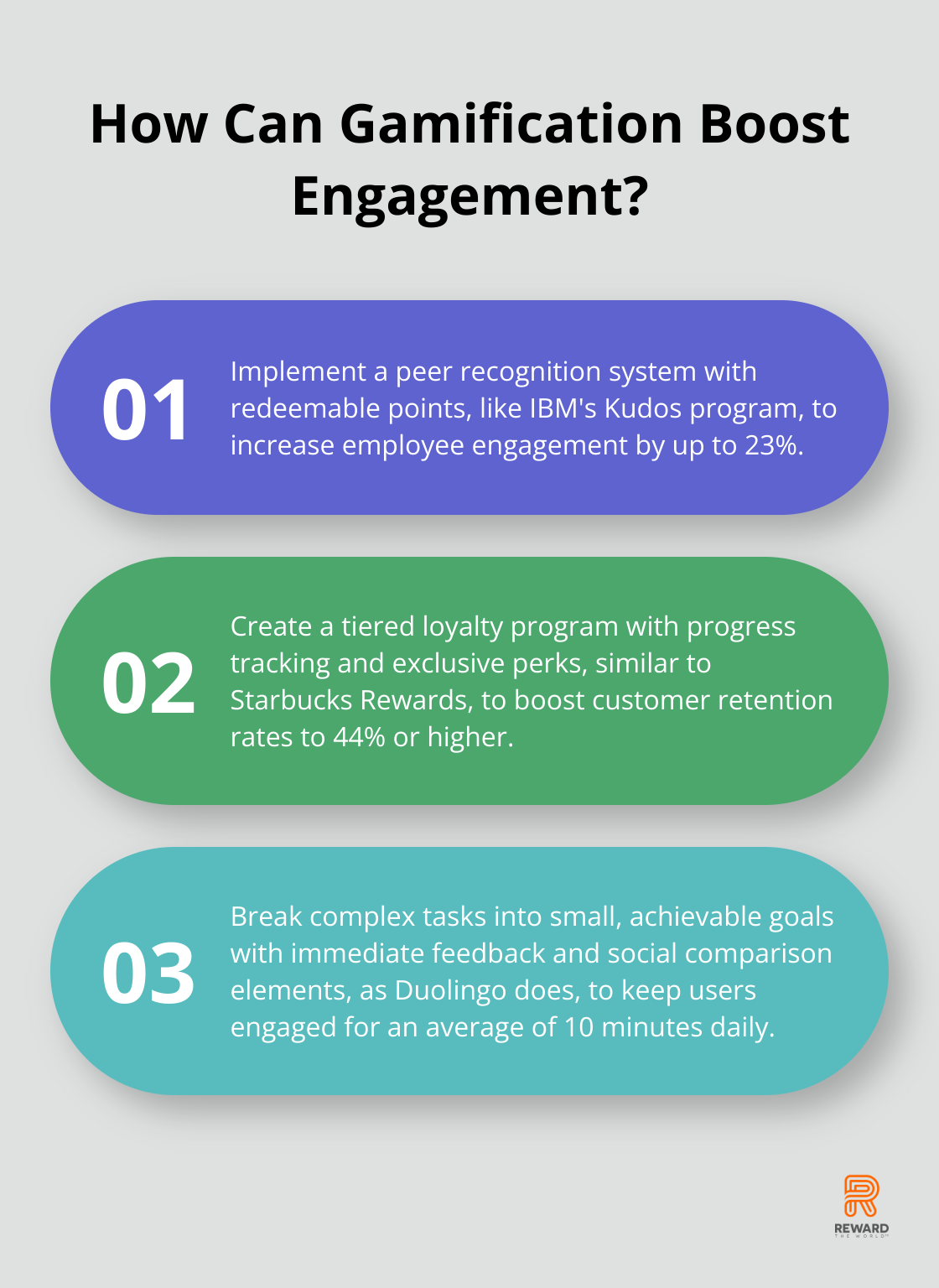
Gamification has become a powerful tool in modern business strategies. At Reward the World, we’ve seen firsthand how understanding the psychology behind gamification can lead to remarkable results.
The science of gamification psychology reveals why certain techniques captivate users and drive behavior. In this post, we’ll explore the key principles that make gamification so effective and how businesses can harness them for success.
What Makes Gamification Tick in Business?
The Essence of Business Gamification
Gamification in business transcends the simple addition of game elements to work processes. It represents a strategic approach that harnesses human psychology to drive engagement and results. At its core, gamification applies game design principles in non-game contexts to motivate specific behaviors.
The Science of Engagement
The success of gamification stems from its ability to trigger key psychological responses. A TalentLMS study revealed that 89% of employees felt more productive in a gamified workplace. This productivity boost originates from the activation of the brain’s reward system. Task completion and immediate feedback or rewards prompt dopamine release, creating a sense of pleasure and motivation to continue.
Key Elements Driving Results
Effective gamification strategies incorporate several vital components:
- Clear Goals: Specific, achievable objectives provide users with a sense of purpose and direction.
- Progress Tracking: Visual representations of advancement (e.g., progress bars or levels) tap into our innate desire for completion.
- Immediate Feedback: Quick responses to actions reinforce positive behaviors and guide improvement.
- Social Interaction: Leaderboards and team challenges leverage our natural inclination for competition and collaboration.
- Meaningful Rewards: Incentives that align with user values enhance motivation and satisfaction.
Real-World Applications
Gamification transforms business outcomes across various sectors. For instance, a global retail chain implemented a gamified loyalty program. The program’s success stemmed from its personalized challenges and instant reward system, which kept customers engaged and returning for more.

In another case, a tech startup gamified their onboarding process. By creating a series of “quests” for new hires to complete, they reduced time-to-productivity and increased employee satisfaction scores.
Implementing Effective Gamification
To implement gamification effectively, businesses should:
- Identify clear objectives
- Understand their target audience’s motivations
- Design a system that balances challenge and achievability
- Ensure users feel both competent and motivated to improve
Regular analysis and adjustment of gamification strategies prove vital. User feedback and performance metrics should guide ongoing refinements to maintain engagement and effectiveness over time.
The Future of Gamification
The integration of AI and machine learning in gamification platforms promises even more personalized and adaptive experiences. This evolution will allow businesses to create increasingly sophisticated and effective gamification strategies, driving engagement and performance to new heights. (As we move forward, we’ll explore how these advancements in technology shape the future of gamification in business.)
How Businesses Can Tap into Human Motivation
The Power of Intrinsic Motivation
Intrinsic motivation, driven by personal interest and enjoyment, forms the foundation of long-term engagement. Research has found that organizations that focus on fostering intrinsic motivation see a 10% increase in productivity compared to those that solely rely on extrinsic motivation. To tap into this powerful force, businesses should:
- Offer autonomy: Allow users to choose their own paths and goals within the gamified system.
- Provide opportunities for mastery: Design challenges that gradually increase in difficulty, allowing users to develop and showcase their skills.
- Connect to a larger purpose: Clearly communicate how individual actions contribute to broader company or societal goals.
Balancing Extrinsic Rewards
While intrinsic motivation is important, extrinsic rewards play a vital role in initial engagement and maintaining momentum. The key is to strike the right balance. TalentLMS provides original statistics and insight on some of the most trending employee training, learning and workplace related topics. To effectively use extrinsic motivators:
- Implement a varied reward system: Offer a mix of tangible (e.g., gift cards, bonuses) and intangible rewards (e.g., recognition, status symbols).
- Use unexpected rewards: Surprise bonuses or achievements can boost dopamine levels and reinforce positive behaviors.
- Ensure rewards are meaningful: Tailor incentives to your audience’s preferences and values.
Progress Tracking and Achievement Systems
Visible progress and achievements are powerful motivators. Implement these strategies:
- Use progress bars: Visualize advancement towards goals to tap into the completion bias.
- Implement milestone rewards: Offer special incentives for reaching significant achievements.
- Provide real-time feedback: Use notifications or pop-ups to immediately acknowledge user actions and progress.
Crafting Meaningful Challenges
The right level of challenge is essential for maintaining engagement. Too easy, and users get bored; too difficult, and they become frustrated. Try to find the sweet spot:
- Personalize difficulty: Use AI algorithms to adjust challenge levels based on individual user performance.
- Implement progressive difficulty: Gradually increase complexity as users advance through the system.
- Offer choice: Allow users to select from a range of challenges suited to their skill level and interests.
Social Elements and Competition
Humans are inherently social creatures, and leveraging this can significantly boost motivation. Incorporate social elements:
- Create team challenges: Foster collaboration and healthy competition between groups.
- Implement leaderboards: Showcase top performers to drive friendly competition.
- Enable social sharing: Allow users to share their achievements on social media or internal platforms.

The effectiveness of gamification strategies can wane over time. Regular assessment and adjustment are essential. Collect user feedback, analyze engagement metrics, and continuously update challenges, rewards, and game mechanics to keep the experience fresh and engaging.
Understanding these psychological principles allows businesses to create gamification systems that drive short-term engagement and foster long-term motivation and loyalty. The key lies in balancing intrinsic and extrinsic motivators, providing meaningful challenges, and adapting to user needs and preferences.
As we move forward, we’ll explore real-world examples of successful gamification strategies (including those implemented through platforms like Reward the World) and how they’ve transformed employee engagement, customer loyalty, and training programs across various industries.
Real-World Gamification Success Stories
IBM’s Employee Engagement Transformation
IBM revolutionized its employee engagement with the gamified Kudos system. This peer-to-peer recognition platform allows employees to award points to colleagues for outstanding work. Employees can redeem these points for tangible rewards. The results were impressive: this program has not only improved employee morale and motivation but has also led to a 23% increase in employee engagement levels at Cisco.

The success of IBM’s system highlights the power of peer recognition combined with tangible rewards. Companies that want to implement similar systems should prioritize a user-friendly interface and offer a wide variety of meaningful rewards.
Starbucks’ Customer Retention Breakthrough
Starbucks’ gamified loyalty program, Starbucks Rewards, has transformed customer retention. The program uses a tiered system where customers earn “stars” for purchases, which they can redeem for free drinks, food items, and exclusive merchandise. Their customer retention rate is 44%, significantly higher than the industry average of 25%. The gamified loyalty program has also increased customer visits and revenue from loyalty program members.
The program’s success stems from its use of progress tracking (customers can see their “star” count increase in real-time) and exclusivity (offering special perks to higher-tier members). These elements tap into powerful psychological motivators.
Duolingo’s Language Learning Revolution
Duolingo has masterfully applied gamification to language learning. The app incorporates various game elements, including progress bars, daily streaks, and competitive leaderboards. These features have led to over 500 million downloads and a user base that spends an average of 10 minutes per day on the app.
Duolingo’s success lies in its ability to break complex tasks (learning a language) into small, achievable goals. This approach, combined with immediate feedback and social comparison elements, keeps users motivated and engaged.
Nike’s Fitness Gamification Success
Nike+ Run Club app has successfully gamified fitness. The app tracks users’ runs, offers personalized coaching, and allows users to compete with friends. It also includes challenges and achievements to keep users motivated. Since its launch, the app has garnered over 50 million users worldwide.
The app’s success demonstrates how gamification can transform a solitary activity into a social, competitive experience. It also shows the power of personalized goals and immediate feedback in maintaining user engagement.
Microsoft’s Productivity Boost Through Gamification
Microsoft implemented a gamified system called Language Quality Game to improve the quality of Windows 7 language translations. Employees could review and score translations, earning points and competing on leaderboards. This initiative resulted in employees reviewing Windows dialogues, significantly improving the product’s quality.
This case study shows how gamification can boost productivity and quality. It also demonstrates the potential of gamification in large-scale, collaborative projects.
Final Thoughts
Gamification psychology taps into fundamental human motivations, driving engagement and behavior change in powerful ways. The success stories we examined demonstrate how well-designed gamification strategies transform business outcomes across various sectors. Key psychological principles underpinning effective gamification include the balance of intrinsic and extrinsic motivation, the power of immediate feedback, and the importance of social connection.

Businesses must start with clear objectives and a deep understanding of their target audience when implementing gamification strategies. They should design systems that offer the right level of challenge, provide meaningful rewards, and allow for personalization. Regular assessment and iteration based on user feedback and performance metrics will maintain long-term engagement.
The integration of AI and machine learning will take gamification to new heights, enabling more sophisticated personalization and adaptive challenges. At Reward the World, we offer a comprehensive platform that harnesses the power of gamification psychology to drive customer loyalty, boost sales, and enhance employee recognition. Our global reach and instant reward delivery help businesses implement effective gamification strategies that deliver tangible results.
